- Home
- About
- Map
- Trips
- Bringing Boat West
- Migration West
- Solo Motorcycle Ride
- Final Family XC Trip
- Colorado Rockies
- Graduates' XC Trip
- Yosemite & Nevada
- Colorado & Utah
- Best of Utah
- Southern Loop
- Pacific Northwest
- Northern Loop
- Los Angeles to NYC
- East Coast Trips
- Martha's Vineyard
- 1 Week in Quebec
- Southeast Coast
- NH Backpacking
- Martha's Vineyard
- Canadian Maritimes
- Ocracoke Island
- Edisto Island
- First Landing '02
- Hunting Island '02
- Stowe in Winter
- Hunting Island '01
- Lake Placid
- Chesapeake
- Provincetown
- Hunting Island '00
- Acadia in Winter
- Boston Suburbs
- Niagara Falls
- First Landing '99
- Cape Hatteras
- West Coast Trips
- Burning Man
- Utah Off-Roading
- Maui
- Mojave 4WD Course
- Colorado River Rafting
- Bishop & Death Valley
- Kauai
- Yosemite Fall
- Utah Off-Road
- Lost Coast
- Yosemite Valley
- Arizona and New Mexico
- Pescadero & Capitola
- Bishop & Death Valley
- San Diego, Anza Borrego, Joshua Tree
- Carmel
- Death Valley in Fall
- Yosemite in the Fall
- Pacific Northwest
- Utah Off-Roading
- Southern CA Deserts
- Yosemite & Covid
- Lake Powell Covid
- Eastern Sierra & Covid
- Bishop & Death Valley
- Central & SE Oregon
- Mojave Road
- Eastern Sierra
- Trinity Alps
- Tuolumne Meadows
- Lake Powell Boating
- Eastern Sierra
- Yosemite Winter
- Hawaii
- 4WD Eastern Sierra
- 4WD Death Valley +
- Southern CA Deserts
- Christmas in Tahoe
- Yosemite & Pinnacles
- Totality
- Yosemite & Sierra
- Yosemite Christmas
- Yosemite, San Diego
- Yosemite & North CA
- Seattle to Sierra
- Southwest Deserts
- Yosemite & Sierra
- Pacific Northwest
- Yosemite & South CA
- Pacific Northwest
- Northern California
- Southern Alaska
- Vancouver Island
- International Trips
- Index
- Tips
- Books
- Photos/Videos
- Search
- Contact
Home
Saturday, March 2, 2019 - 11:45am by Lolo570 miles and 10.5 hours from our last stop - 1 night stay
Tecate Border Crossing and Days Inn outside of San Diego
Friday, March 1, 2019 - 11:45am by Lolo90 miles and 2 hours from our last stop - 1 night stay
Travelogue
As predicted, the Tecate border crossing was quick and uneventful. It was quite sad though to see several families with young children pleading to get a ride once across the border. There is pretty much nothing but 30 miles mountainous, winding roads between the border and civilization. It's pretty heartbreaking to see.
We drove for about an hour before settling in for the night (our last on the road) at a Days Inn Wyndham outside of San Diego.
Description
One of Baja's three border crossings into the U.S.
Valle de Guadalupe and La Ruta del Vino
Friday, March 1, 2019 - 11:30am by Lolo250 miles and 6.5 hours from our last stop
Travelogue
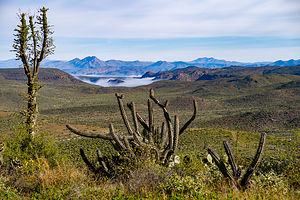 Along the road north on Mexico 1877 miles to go.
Along the road north on Mexico 1877 miles to go.
However, we did have a fun event planned for the day: visiting a winery in the Valle de Guadalupe, Mexico’s version of Napa Valley. We live in Sonoma Valley, so we were curious to see what their wine country was like.
Based on advice from fellow travelers we had met along the way, we were going to cross the border in Tecate rather than Tijuana. Besides being a quicker border crossing, this route would bring us along La Ruta de Vino (Wine Route), a rapidly growing wine region in northern Baja, just an hour south of the Tecate border crossing.
 Wildflower bloom along Mexico 1La Ruta del Vino (Wine Route) is the name given to the roads that connect the more than 120 boutique wineries in the valley. There are only three paved road in the Valle de Guadalupe, the rest being a network of unnamed dirt roads. Blue signs designate the turn-offs from the paved roads for various wineries and restaurants.
Wildflower bloom along Mexico 1La Ruta del Vino (Wine Route) is the name given to the roads that connect the more than 120 boutique wineries in the valley. There are only three paved road in the Valle de Guadalupe, the rest being a network of unnamed dirt roads. Blue signs designate the turn-offs from the paved roads for various wineries and restaurants.
In addition to the varietals we are familiar with in the states, lesser known grapes, such as the Spanish tempranillo and the Italian nebbiolo, are grown here. Also, the region produces many blends, thus creating unique taste profiles not found anywhere else.
The demands for wines from this valley is so great in Mexico, that 96% of the wines produced here go to Mexico City. Because of this great demand, U. S. citizens are only allowed to bring back one liter of wine per adult into the U.S. every 30 days.
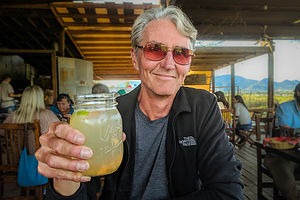 Enjoying lunch at Finca Altozano in the Valle de GuadalupeIn addition to great wines, there is great food to be found at one of the many outdoor campestre restaurants serving gourmet farm-to-table food with views of the vineyards.
Enjoying lunch at Finca Altozano in the Valle de GuadalupeIn addition to great wines, there is great food to be found at one of the many outdoor campestre restaurants serving gourmet farm-to-table food with views of the vineyards.
Since this was a long driving day for us, we were more interested in the food rather than the wine. We chose Finca Altozano, a campestre that received a star rating in our Moon Baja guidebook. That guide had not steered us wrong yet in its recommendations.
The restaurant was located about a mile down a dirt road off La Ruta del Vino. Compared to the places we passed along the way, the parking lot was quite full - always a good sign.
The atmosphere was lovely, open-air dining with views overlooking the vineyards, and the food was excellent. I had an incredible pasta dish with their house-made sausage and Herb had a breaded Chicken Milanese. A refreshing wine spritzer with melons and oranges completed our fabulous lunch.
 Lolo enjoying the view from atop a wine barrel at Finca Altozano in the Valle de GuadalupeAfterwards, we walked around the property, where they’ve turned large wine barrels into lookouts with benches at the top. What a great place it would have been to sip a glass of wine and enjoy the views if we didn’t have a border crossing and miles of driving still ahead of us.
Lolo enjoying the view from atop a wine barrel at Finca Altozano in the Valle de GuadalupeAfterwards, we walked around the property, where they’ve turned large wine barrels into lookouts with benches at the top. What a great place it would have been to sip a glass of wine and enjoy the views if we didn’t have a border crossing and miles of driving still ahead of us.
The rest of the day went smoothly. The Tecate border crossing was quick and uneventful. We spent that night, our last on the road, at a Days Inn outside of San Diego.
Description
Often referred to as the “Napa of Mexico,” the Valle de Guadalupe is a rapidly growing wine region in northern Baja, just an hour south of the Tecate border crossing. As a result, it is a popular weekend destination for people from the San Diego area.
La Ruta del Vino (Wine Route) is the name given to the roads that connect the many wineries in the valley. There are only three paved road in the Valle de Guadalupe, the rest being a network of unnamed dirt roads. Blue signs designate the turn-offs from the paved roads for various wineries and restaurants.
Although wine has been made in this region for over 100 years, it has only been in the past 20 that it has received some well-deserved attention. Today, there are over 120 boutique wineries producing small batches of high-quality, award winning wines.
In addition to the varietals Americans are familiar with, other grapes, such as the Spanish tempranillo and the Italian nebbiolo, may be less known. Also, the region produces many blends, thus creating unique taste profiles not found anywhere else.
90% percent of the wines from Mexico come from this region, and 96% of the wines produced here go to Mexico City. That is why they have not received much exposure outside of Mexico.
Because of this great demand, U. S. citizens are only allowed to bring back one liter of wine per adult into the U.S. every 30 days.
In addition to great wines, there is great food to be found at one of the many outdoor campestre restaurants serving gourmet farm-to-table food with views of the vineyards.
Mision San Francisco Javier
Monday, February 25, 2019 - 8:30am by Lolo105 miles and 2.5 hours from our last stop
Travelogue
 Mision San Francisco JavierAs per the experienced Baja travelers we met in Kuyima, we left Mulege a day early and headed towards Loreto, where we had just made reservations for the night at a place called Coco Cabanas.
Mision San Francisco JavierAs per the experienced Baja travelers we met in Kuyima, we left Mulege a day early and headed towards Loreto, where we had just made reservations for the night at a place called Coco Cabanas.
On the way down Mexico 1, we stopped at Playa El Requeson, the beach I had marked in my trip planning notes as the best place to camp, to see if it was something we would like to do on our way back north. It was. The beach was much quieter than Playa Santispac, with much fewer RVs. Not sure why, as it was much prettier. Perhaps it was the lack of a restaurant on the beach.
 Interior of Mision San Francisco JavierWe very much wanted to see the remote Mision San Francisco Javier, a highly recommended side trip from Loreto, so before heading over to our hotel, we took the gorgeous 24-mile, steep and winding drive from Mexico 1, through the scenic valley of the Sierra de la Giganta, to the tiny agricultural town of San Javier. The views of the craggy peaks of the Giganta along the way alone were worth the trip.
Interior of Mision San Francisco JavierWe very much wanted to see the remote Mision San Francisco Javier, a highly recommended side trip from Loreto, so before heading over to our hotel, we took the gorgeous 24-mile, steep and winding drive from Mexico 1, through the scenic valley of the Sierra de la Giganta, to the tiny agricultural town of San Javier. The views of the craggy peaks of the Giganta along the way alone were worth the trip.
The town was lovely, set against a backdrop of black lava cliffs. There was only one street through town, lined with two restaurants and a souvenir shop, coming to an end at the steps of the beautiful stone structure of the mission.
We had been to two missions in Baja so far - San Ignacio and Mulege - but this one was by far the most impressive. It is considered the crown jewel of the Baja mission system, because of its impressive architecture and its excellent state of preservation.
 Interior of Mision San Francisco JavierOutside the mission, there were several informative historical placards detailing its history. The following is a brief, summarized version:
Interior of Mision San Francisco JavierOutside the mission, there were several informative historical placards detailing its history. The following is a brief, summarized version:
The mission was founded in 1699 by Padre Francisco Maria Piccolo. However, during a drought, in 1710, it was moved 5 miles south to its present location because of its better access to fresh water and fertile soil. The goal of every mission was self-sufficiency, and this new location would allow them to grow their own crops, such as grapes, olives, and citrus.
The church here today was built from 1744 to 1758, and remains the finest preserved stone mission in Baja. The mission features the first glass windows in Baja, three gold-leaf altars shipped from mainland Mexico, and a spiral staircase leading up to the choir loft. Dominating the altar is a statue of San Francisco Javier, surrounded by eight large oil paintings.
Armed with knowledge, we stepped through the double portal and wandered through the interior of this very impressive church, taking note (and photographs) of the features we had learned about.
 315-year-old olive tree (plus us)However, by far my favorite was the statue of a female saint (or possibly martyr?) set in the niche of a closed portal to the left of the altar. She was clothed in a black, formless cloak and crown of sorts, that left only her face exposed, in an expression that I can best describe as pure ecstasy. Adorning the portal surrounding her were a few more disembodied heads, with much more mundane, earthly expressions. I really wanted to know the story behind this, but could find no information either there or in later google churches. Her image was haunting.
315-year-old olive tree (plus us)However, by far my favorite was the statue of a female saint (or possibly martyr?) set in the niche of a closed portal to the left of the altar. She was clothed in a black, formless cloak and crown of sorts, that left only her face exposed, in an expression that I can best describe as pure ecstasy. Adorning the portal surrounding her were a few more disembodied heads, with much more mundane, earthly expressions. I really wanted to know the story behind this, but could find no information either there or in later google churches. Her image was haunting.
After visiting the interior of the church, we strolled around back to the gardens, where you can still see the wells, dams, and irrigation channels built by the mission founders. It was quite lush, and date palms, citrus, grapes, and olive trees are still grown here. I can understand why they chose this location.
The most impressive example of their plantings was an enormous, 315-year-old olive tree, with gnarled branches extending in every direction. By my calculation, that tree had to have been planted almost immediately upon their mission’s move to this location.
The tree was the perfect backdrop for what turned out to be Herb and my first, and only, photograph of us together on this trip.
 Mision San Francisco Javier's backyardWalking back from the gardens, we were treated to a very different perspective of the mission. From the front, it dominates the scene. However, from the back, with the black lava cliffs of the Sierra de la Giganta rising above it, it takes on a more humble role amidst nature’s glory.
Mision San Francisco Javier's backyardWalking back from the gardens, we were treated to a very different perspective of the mission. From the front, it dominates the scene. However, from the back, with the black lava cliffs of the Sierra de la Giganta rising above it, it takes on a more humble role amidst nature’s glory.
Before leaving town, we decided to have lunch. We sat down at a table in Restaurant La Palapa, which was the only one mentioned in this town in Moon Baja, but were totally ignored. When a tour bus pulled into town, we figured we would never get served, so we got up and went across the street to Betty’s, where we had a very good, and quickly served, lunch of quesadillas and beef burritos.
Time to head back down the twisty road to Loreto and check out our accommodations for the night.
Description
 Portals of Mision San Francisco JavierThe Mision San Francisco Javier is the crown jewel of the Baja missions because of its beauty and excellent state of preservation. It is the most architecturally impressive mission on the peninsular, as well as best preserved. Adding to its allure is its spectacular remote setting against a backdrop of the spectacular black lava cliffs of the Sierra de la Giganta.
Portals of Mision San Francisco JavierThe Mision San Francisco Javier is the crown jewel of the Baja missions because of its beauty and excellent state of preservation. It is the most architecturally impressive mission on the peninsular, as well as best preserved. Adding to its allure is its spectacular remote setting against a backdrop of the spectacular black lava cliffs of the Sierra de la Giganta.
Padre Francisco Maria Piccolo founded the mission in 1699, but during a drought in 1710, it was moved 5 miles south to its present location which had better access to fresh water and fertile soil. This new location would allow them to grow their own crops, such as grapes, olives, and citrus. Today you can still see the wells, dams, and irrigation channels that they built, as well as a 315-year-old olive tree, in the gardens behind the mission.
The church was built from 1744 to 1758, and remains the finest preserved stone mission in Baja. The mission features the first glass windows in Baja, three gold-leaf altars shipped from mainland Mexico, and a spiral staircase leading up to the choir loft. Dominating the altar is a statue of San Francisco Javier, surrounded by eight large oil paintings.
The Mision is a must-do side trip from Loreto. From Mexico 1 (at km 118), drive southwest for 24 miles to the tiny agricultural town of San Javier. The drive through scenic valley and peaks of the Sierra de la Giganta is worth the trip alone.
Back to Catavina
Thursday, February 28, 2019 - 7:15pm by Lolo344 miles and 7.5 hours from our last stop - 1 night stay
Travelogue
 My favorite roadside graffitiThe fun part of the trip was pretty much over. Our southernmost destination on the peninsular had been Loreto, and we had started our journey back north with last night’s stop on Playa El Requeson, where a beautiful sunrise greeted us the this morning.
My favorite roadside graffitiThe fun part of the trip was pretty much over. Our southernmost destination on the peninsular had been Loreto, and we had started our journey back north with last night’s stop on Playa El Requeson, where a beautiful sunrise greeted us the this morning.
There are not many choices of roads in Baja, so we would have to retrace our steps along Mexico 1, back through Mulege, Santa Rosalia, Las Tres Virgenes, San Ignacio, Catavina, and San Quintin. We did, however, make the decision to cross the border in Tecate rather than Tijuana this time, both because it was rumored to be quicker and also because it would allow us to see something new along Mexico 3 - the Valle de Guadalupe and its burgeoning wine country.
I put “Home” into Google Maps, and it said 1,222 miles. Oh boy! We would have to figure out some fun breaks along the way.
 Cacti outside of CatavinaSo far, all I was coming up with was trying to find a building that I had wanted to photograph on the way down, but weren’t able pull over in time - and there are not many opportunities for a U-turn on these narrow roads. I wrote myself an email describing its location, on the chance that we could find it on our way back north.
Cacti outside of CatavinaSo far, all I was coming up with was trying to find a building that I had wanted to photograph on the way down, but weren’t able pull over in time - and there are not many opportunities for a U-turn on these narrow roads. I wrote myself an email describing its location, on the chance that we could find it on our way back north.
About 5 hours into our otherwise uneventful drive, I told Herb that I thought we were getting close. There was not much else along this stretch of highway, so when I saw a white, rather decrepit building just ahead, I told him to pull in. There it was - an old, crumbling building with graffiti all over it, the best of which were large black letters saying “Make America Mexico Again.” Herb was quite impressed with my navigational abilities.
That was pretty much our highlight for the day, with the exception of some pretty awesome cacti just outside of Catavina.
 Predawn cactusThere weren’t that many great choices of lodging along this stretch of the road, except for the Hotel Mision Catavina, where we had stayed on the way down. Fortunately, they had room for us. It was much warmer than on our way down, so I attempted to sit by the pool for a bit, while Herb napped after our long drive.
Predawn cactusThere weren’t that many great choices of lodging along this stretch of the road, except for the Hotel Mision Catavina, where we had stayed on the way down. Fortunately, they had room for us. It was much warmer than on our way down, so I attempted to sit by the pool for a bit, while Herb napped after our long drive.
The next morning, Herb got up before sunrise and went out by himself to photograph the cacti in the morning light. When I saw the photo he took, I wish I had dragged myself out of bed to join him.
Going back to my rather cliche analogy of the optical illusion of the old woman and the pretty young girl, upon our reentry into northern Baja with its contrasts and extremes, we were being visited by both of them.
Description
 Looking out our hotel windowCatavina is a small town in the middle of the desert with a mini market and one hotel. There is no longer a gas station, but in its place are several pickup trucks selling barrel gas. Because there is not much between El Rosario and Guerrero Negro, it is a popular overnight stop for people passing through.
Looking out our hotel windowCatavina is a small town in the middle of the desert with a mini market and one hotel. There is no longer a gas station, but in its place are several pickup trucks selling barrel gas. Because there is not much between El Rosario and Guerrero Negro, it is a popular overnight stop for people passing through.
However, beyond its convenience as a stopover, Catavina has much to offer on its own. The terrain around the small town is a photographer's paradise, with its striking boulder fields sprinkled with cacti and desert plants.
Also nearby are the Catavina Pinturas Rupestres, the most easily accessible cave paintings in Baja. To find them, at kilometer 76 look for the INAH sign on the east side of Mexico 1. Park your car hear and follow the well-marked trail up the hill to the paintings - about a 10 minute walk. Their are informational signs along the way explaining the history and significance of this site. Unfortunately, they were all written in Spanish.
The paintings are tucked inside a small cave at the top of a hill. The drawings, done in yellow, red, and black minerals, depict a sun, geometric designs, and other abstract shapes. They were believed to have been created about a 1,000 years ago by the Cochimi people.
Playa El Requeson on the Bahia Concepcion
Wednesday, February 27, 2019 - 7:00pm by Lolo60 miles and 1.25 hours from our last stop - 1 night stay
Travelogue
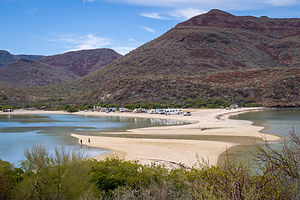 Playa El Requeson on Bahia ConcepcionThe weather was finally in our favor - our third day of sun and warmth, without gusty winds. Looks like we were finally going to get our beach camping in, which was one of our major goals while in Baja.
Playa El Requeson on Bahia ConcepcionThe weather was finally in our favor - our third day of sun and warmth, without gusty winds. Looks like we were finally going to get our beach camping in, which was one of our major goals while in Baja.
Before leaving on this trip, I had scouted out Playa El Requeson on the Bahia Concepcion as the best beach to tent camp on. On our way south to Loreto, we had actually stopped there to check it out, and it was definitely what we were looking for - much quieter than Playa Santispac, with fewer RVs, and a lovely sandbar connecting it to a small rocky island.
It took us about an hour and a half to get there from Loreto. It would have been less if we hadn’t been stopped and searched at a military checkpoint along the way. We had been through several of these already during out time in Baja. They were quite intimidating at first - men in army fatigues holding automatic rifles can make even the most innocent feel a bit nervous and ready to confess. However, since up until now, they had just asked us where we were going, and then waved on us on through.
 Camping on Playa El Requeson on Bahia ConcepcionThis time, however, they asked us politely if they could look at the contents of our car. They said this in Spanish, but we got the gist of it. What were we going to do, say no? So, we stepped out of the car while one of them looked in our glove compartment, center console, luggage, etc. I realized I had some sand dollars that I had picked up on the beach in the pocket on the door, which you are not supposed to take, so I started to sweat. Fortunately, I think they were more interested in drugs and firearms.
Camping on Playa El Requeson on Bahia ConcepcionThis time, however, they asked us politely if they could look at the contents of our car. They said this in Spanish, but we got the gist of it. What were we going to do, say no? So, we stepped out of the car while one of them looked in our glove compartment, center console, luggage, etc. I realized I had some sand dollars that I had picked up on the beach in the pocket on the door, which you are not supposed to take, so I started to sweat. Fortunately, I think they were more interested in drugs and firearms.
During the search, I was trying to chat up the three soldiers who were not holding automatic rifles, which I think is something you are advised not to do, but they were very friendly. Either because they had completed the search, or were tired of my feeble attempts at Spanish, they waved us on.
Soon after, we drove down the road to Playa El Requeson and situated ourselves in a great spot right near the sandbar, in such a way that no campers that arrived later would obstruct our view.
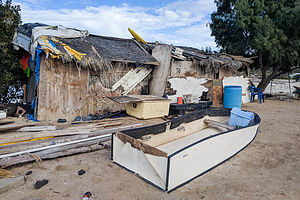 Campground host? - Playa El Requeson on Bahia ConcepcionWithout further ado we walked across the sandbar until it ended, and then waded the remaining 20 yards or so to a rocky island. We followed a sandy path through the brush and then clambered up some rocks to the top of the ridge, where there was a great view of our 4Runner camped on the beach.
Campground host? - Playa El Requeson on Bahia ConcepcionWithout further ado we walked across the sandbar until it ended, and then waded the remaining 20 yards or so to a rocky island. We followed a sandy path through the brush and then clambered up some rocks to the top of the ridge, where there was a great view of our 4Runner camped on the beach.
After lunch, I took a stroll down the beach, stopping to photograph an old dilapidated building and boat. I have no idea what it once had been - private home or beach facility? - but in either case, it was long past its prime, like so many other structures we had encountered along the way. Continuing on I came to the end of the beach, where a road led along the shore to a small house. Not knowing if it was private property or not, I turned back.
We spent the afternoon in our camp chairs just reading and watching the activity around us - seagulls looking for a handout, a girl posing at the end of the sandbar for a drone overhead, a little boy crying after getting bit by a crab, wild horses crossing the far end of the beach, and our RV neighbor running coming out of his RV swinging a lasso in their direction. I was intrigued. Who the heck packs a lasso on vacation just in case a wild horse goes by? I just had to ask. It turns out he ropes cattle in rodeos in eastern Oregon.
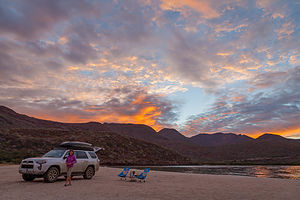 Evening light - Playa El Requeson on Bahia ConcepcionNext, a truck stopped right by us and a man came out carrying a tray of colorful, carved wooden figurines, most of them animals. He said his grandfather carved them and he painted them. They were cute and handmade, so we bought a balene for 100 pesos (about $5). Besides actually liking it, we wanted to do our part for the local economy.
Evening light - Playa El Requeson on Bahia ConcepcionNext, a truck stopped right by us and a man came out carrying a tray of colorful, carved wooden figurines, most of them animals. He said his grandfather carved them and he painted them. They were cute and handmade, so we bought a balene for 100 pesos (about $5). Besides actually liking it, we wanted to do our part for the local economy.
Later on, a very old woman, kind of scary looking, came by carrying an old shoebox, which she opened for us, revealing some tiny, not particularly appealing ceramic turtles. When I asked her how much, she said “cinquenta pesos.” I mistakenly thought that meant 500 (about $25) so, thinking she was trying to rip me off, I said, “No gracias.” I really need to work on my Spanish numbers, as cinquenta means 50, which is the equivalent of about $2.50. However, by the time I realized this, she was long gone. I felt terrible that I didn’t buy one of her turtles, as I am sure she could have used the 50 pesos more than us.
 Bioluminescent plankton along El Playa RequesonThis was turning out to be a busier place than we anticipated.
Bioluminescent plankton along El Playa RequesonThis was turning out to be a busier place than we anticipated.
However, at dusk the show really began, as the sky lit up in brilliant shades of red, yellow, and blue.
As if that wasn’t spectacular enough, when it got completely dark, I happened to notice a bright neon blue light running along the water’s edge. At first we thought it was someone’s headlights, but there was no vehicle nearby.
We walked over to take a look. It was bioluminescent plankton!! What a magical sight. The phenomenon is caused by a tiny microscopic dinoflagellate called Noctiluca, or sea sparkle, that flashes a bright blue when disturbed, making the water sparkle. The lapping of the water along the shoreline must have provided the necessary disturbance to set off their alarms.
It gets even better. When our eyes followed the shimmering neon blue light to its end, we saw that it met up with the ladle of the big dipper!
This experience, plus seeing the gray whales in Laguna San Ignacio, made every one of the 2,700 miles we would drive this trip well worth the effort.
Description
 Watercolor sunsetJust south of Mulege is the Bahia Concepcion, a series of shallow bays with picturesque turquoise waters and white sandy beaches. It has become a mecca for snowbirds traveling south in the winter for warmth and sunshine. There are over a dozen beaches to camp on or just enjoy for the day.
Watercolor sunsetJust south of Mulege is the Bahia Concepcion, a series of shallow bays with picturesque turquoise waters and white sandy beaches. It has become a mecca for snowbirds traveling south in the winter for warmth and sunshine. There are over a dozen beaches to camp on or just enjoy for the day.
The Playa El Requeson (km 91.5) is one of the more popular ones, especially for tent camping. A sandbar connects to shore to a small rocky island.
Loreto
Monday, February 25, 2019 - 7:00pm by Lolo25 miles and 1 hour from our last stop - 2 night stay
Travelogue
 Our Coco Cabana casitaI was really excited about visiting Loreto. Everyone we met along the road had raved about it. When we decided to bug out a day early from Mulege, we went online and searched for hotels in Loreto with availability for the following night that were written up in our Moon guide. Coco Cabanas and Casitas came up, and the description and its location looked great, so we booked it for one night.
Our Coco Cabana casitaI was really excited about visiting Loreto. Everyone we met along the road had raved about it. When we decided to bug out a day early from Mulege, we went online and searched for hotels in Loreto with availability for the following night that were written up in our Moon guide. Coco Cabanas and Casitas came up, and the description and its location looked great, so we booked it for one night.
As I mentioned in the previous stop, we made the very worthwhile side trip to the lovely Mision San Francisco Javier before checking into Coco Cabanas.
I’m not sure if we booked a cabana or a casita at Coco’s, butwhatever it was, it was great. There was a large kitchen and dining area with a full-size refrigerator, microwave, coffee maker, stove, pots and pans, plates, glasses, etc. I had no intention of cooking, but it was nice to have as an option.
 Coco Cabanas and Casitas poolStephan, the owner, turned out to be from Petaluma, California, which is two towns over from where we live in Sonoma County, so we chatted about that for a bit. He bought this place about 8 years ago, and only goes back to the States to visit his mother.
Coco Cabanas and Casitas poolStephan, the owner, turned out to be from Petaluma, California, which is two towns over from where we live in Sonoma County, so we chatted about that for a bit. He bought this place about 8 years ago, and only goes back to the States to visit his mother.
Right outside our room was a lovely pool surrounded by lounge chairs and a BBQ area. I definitely think this place is meant for people staying more than one night. Herb fixed that right away and added a second night onto our stay.
This was our 7th day in Baja, but the first that was warm and sunny enough to actually get into a bathing suit, so we did, and spent the next few hours lying in the sun, reading by the pool. I even took a quick dip.
 Marina along the Loreto MaleconI had to come back home with at least a little bit of a tan. Even after just two hours in the sun, I had managed to get a little bit of color. Herb complimented me in his own unique way and said that I didn’t look so pasty. Thanks, I guess.
Marina along the Loreto MaleconI had to come back home with at least a little bit of a tan. Even after just two hours in the sun, I had managed to get a little bit of color. Herb complimented me in his own unique way and said that I didn’t look so pasty. Thanks, I guess.
That evening we decided to take a walk into the main part of town to see the plaza and the mission. Our hotel was in a perfect location from which to take the ultimate Loreto stroll.
We maneuvered our way past the gang of perros (dogs), gatos (cats), and pollos (chickens) that hung around our street - I don’t think they even sell leashes in Mexico -- and walked down the street one block to the beach. To the left was a long sandy beach with hotels, and to the right was the Malecón, the one mile-long palm-tree-lined pedestrian walkway that runs along the waterfront.
 Californa brown pelican gatheringAbout a quarter mile down the Malecón, we came to a long pier that wrapped around, creating a sheltered cove for a marina of small boats, most of them occupied by California brown pelicans. In fact, there were pelicans everywhere. Some were taking an evening stroll along the pier, others were gathering with friends on the boats, and the more industrious ones were diving bombing through the air in search of dinner - not much different than our plans for the evening.
Californa brown pelican gatheringAbout a quarter mile down the Malecón, we came to a long pier that wrapped around, creating a sheltered cove for a marina of small boats, most of them occupied by California brown pelicans. In fact, there were pelicans everywhere. Some were taking an evening stroll along the pier, others were gathering with friends on the boats, and the more industrious ones were diving bombing through the air in search of dinner - not much different than our plans for the evening.
Herb regretted not bringing his better camera, so we vowed to come back tomorrow night to photograph them during their dinner hour of dive bombing.
 Lolo meandering along the Paseo SalvatierraWe continued along the promenade until we came to its end at the Paseo Salvatierra, another lovely pedestrian walkway, this one leading away from the water, under an arch of topiary trees, towards the plaza and the mission.
Lolo meandering along the Paseo SalvatierraWe continued along the promenade until we came to its end at the Paseo Salvatierra, another lovely pedestrian walkway, this one leading away from the water, under an arch of topiary trees, towards the plaza and the mission.
I loved this place!! Why hadn’t we spent our entire time in Baja here? Well, I guess we earned it by doing it the hard way. Anyone can fly here.
First, we came upon the Plaza Juarez, Loreto’s lively town square, lined with colonial buildings restaurants, and shops. People were dining aire libre (outdoors) at tables on the perimeter of the square, with musicians serenading them - not with standard Mexican tunes, but rather with American oldies like “Hotel California” and “Stairway to Heaven.” The same thing happened to us when we were in Thailand. Everyone just loves American music, or else they are just catering to their audience - elderly American tourists.
 Mision Nuestra Senora de Loreto Concho - the Mother of all MissionsWe weren’t hungry yet because of our big lunch in San Javier, so we decided we would cook back in our casita and go out for dinner somewhere nice tomorrow night.
Mision Nuestra Senora de Loreto Concho - the Mother of all MissionsWe weren’t hungry yet because of our big lunch in San Javier, so we decided we would cook back in our casita and go out for dinner somewhere nice tomorrow night.
A little ways past the plaza was the Mision Nuestra Senora de Loreto Concho. Founded in 1697, this was the first Spanish mission in California (both Alta and Baja). At that time Loreto was the religious center of California, so new missions were built out from here on a network of roads known as El Camino Real. Loreto’s primacy was clearly stated over the church portal, “Cabeza y Madre de las Misiones de Baja y Alta California” (“Head and mother of the Missions of Lower and Upper California”).
Interesting to think that our home in Santa Rosa (once part of Mexico) is pretty close to the Sonoma Mission, which was the last Spanish mission built in California. It made me feel a bit closer to home.
We strolled back along the Malecón to our cozy casita, where we took advantage of our kitchen and made one of our backpacking meals, which we actually enjoy. Tonight’s entree was Idahoan powdered potatoes and Starkist salmon. That plus a glass of wine was just what we were looking for. Tomorrow night we would go out to the best Loreto had to offer.
 Strolling along the Loreto BeachThe next morning, we walked back down to the beach, but this time rather than turn right onto the Malecón, we made a left and took a long. 3-mile stroll along the sandy beach, past beachfront motels and impressive private homes. There was definitely a lot of money in this town, probably much of it from Americans.
Strolling along the Loreto BeachThe next morning, we walked back down to the beach, but this time rather than turn right onto the Malecón, we made a left and took a long. 3-mile stroll along the sandy beach, past beachfront motels and impressive private homes. There was definitely a lot of money in this town, probably much of it from Americans.
It was a lovely setting, sandwiched between the Sea of Cortez and the craggy peaks of the Sierra de la Giganta.
Back at Coco’s we ran into Stephan, our host, and asked him about possible hikes. He recommended Tabor Canyon, a hike he said he loved, but his wife hated, because it involved continuous scrambling over boulders. He also warned us not to leave any valuables in the car.
 At little too much boulder scrambling in Tabor CanyonThis didn’t sound particularly appealing to me, but we decided to take a look anyway. The trailhead was only about 25 minutes away.
At little too much boulder scrambling in Tabor CanyonThis didn’t sound particularly appealing to me, but we decided to take a look anyway. The trailhead was only about 25 minutes away.
Sure enough, in the parking lot at the end of the dirt road, there was glass from a broken car window, making us not too comfortable with being away from the car too long. We did go into the canyon a little ways, scrambling over boulders large and small the entire time. Nervous about leaving the car, and feeling that we had better things to do with our brief time in Loreto, we turned around after about a half mile and returned to our car, which fortunately was just fine.
Back at the casita, we made lunch and worked on our tans by the pool for an hour to two.
Afterwards, we repeated our walk of the previous night and headed out onto the pier, this time armed with Herb’s bigger camera, equipped with faster focusing and a longer telephoto lens. We were going to get good shots of pelicans in all phases of their diving, if we had to stay here all night - or until we got hungry, whichever came first.
 California brown pelican making his diveDozens of California brown pelicans were soaring back and forth over the water right in front of us. Often you would see one point his beak down, contemplating whether a dive would yield a tasty treat. Sometimes it was the signal that he was diving down; other times he would change his mind and continue circling around.
California brown pelican making his diveDozens of California brown pelicans were soaring back and forth over the water right in front of us. Often you would see one point his beak down, contemplating whether a dive would yield a tasty treat. Sometimes it was the signal that he was diving down; other times he would change his mind and continue circling around.
Herb and I developed this system where I would look for potential divers and shout out their location as an hour on the clock. Since they dive at speeds of 41 mph, a quick response was essential to capturing the event. People must have thought I was a crazy woman shouting out random times of the day.
After an hour and a half and over 700 shots taken, Herb announced that he thought he had gotten a decent shot or two (always the ultimate understater). After watching hundreds of pelicans have their dinner, it was now time for ours.
 Entertainment at Mi Loreto RestaurantEveryone we had asked along the way about restaurants in Loreto had recommended Mi Loreto, both for its delicious food and its atmosphere. The TripAdvisor reviews confirmed it.
Entertainment at Mi Loreto RestaurantEveryone we had asked along the way about restaurants in Loreto had recommended Mi Loreto, both for its delicious food and its atmosphere. The TripAdvisor reviews confirmed it.
So, we continued on to the end of the Malecon, turned right onto the Paseo Salvatierra, and then walked right through the Plaza to Mi Loretto, right across from the mission. The place was bustling - obviously a popular choice. We put our names in and were told to come back in a half hour, not exactly a hardship as we could spend the time wandering around the square.
As promised, our table was waiting for us when we returned. The atmosphere was very cozy, and there were three hombres with guitars playing Mexican classics, such as “Guantanamera” and “La Bamba” - no “Hotel California” for us tonight.
 Lolo contemplating her margaritaWe started off with margaritas - I am embarrassed to say, the first of our trip. I hadn‘t had one in a very long time, but I vowed to change that from this point forward. Everyone could use more margaritas in their life. This one was delicious, and quite large.
Lolo contemplating her margaritaWe started off with margaritas - I am embarrassed to say, the first of our trip. I hadn‘t had one in a very long time, but I vowed to change that from this point forward. Everyone could use more margaritas in their life. This one was delicious, and quite large.
The food was the best so far on the trip. I had the flank steak fajitas and Herb, of course, had the chile relleno con queso.
The margaritas were so good that Herb ordered a second one, this time a Mi Loreto Margarita, a larger version of the first. Perhaps that explains his rather uncharacteristic romantic move to purchase the vase on our table to memorialize the evening. Not just any vase they had, but this specific one. $20 American dollars later, the waiter handed us the vase in a bag.
What a great evening, and a great closure to our wonderful visit to Loreto.
Description
 Herb and his margaritaThe picturesque town of Loreto is located in Baja Sur, nestled between the Sierra de la Giganta and the Sea of Cortez. Because of its beauty and historical significance, it was designated a “Pueblo Magico” city in 2012, a distinction given to Mexican cities that offer visitors a “magical experience.” With a new commercial airport, it has become an easy weekend destination from the United States.
Herb and his margaritaThe picturesque town of Loreto is located in Baja Sur, nestled between the Sierra de la Giganta and the Sea of Cortez. Because of its beauty and historical significance, it was designated a “Pueblo Magico” city in 2012, a distinction given to Mexican cities that offer visitors a “magical experience.” With a new commercial airport, it has become an easy weekend destination from the United States.
Some of the major attractions include
- Malecon - palm-lined pedestrian walkway the runs along the waterfront
- Plaza Juarez - Loreto’s lively town square, lined with colonial buildings restaurants, and shops
- Mision Nuestra Senora de Loreto Concho - first Spanish mission in California (both Alta and Baja), founded in 1697. At that time Loreto was the religious center of California, so new missions were built out from here on a network of roads known as El Camino Real. Over to the doorway of the church, it reads “Head and mother of the Missions of Lower and Upper California.”
- Paseo Salvatierra - pedestrian walkway from the mission to the malecon through an arch of topiary trees
Other excursions from Loreto include:
- Boat excursion to one of the five islands off the coast in the Parque Maritimo Nacional Bahia de Loreto to see whales, snorkel, or kayak
- Side trip to Mision San Francisco Javier, the crown jewel of the Baja missions
Mulege
Sunday, February 24, 2019 - 7:00pm by Lolo41 miles and 1 hour from our last stop - 1 night stay
Travelogue
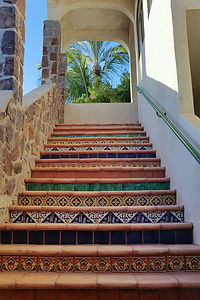 Tiled steps of Hotel Casa GranadaDuring my somewhat overly-cautious, pre-trip planning phase, I had booked two nights at Casa Granada Hotel in Mulege, because it was located at the mouth of the Bay of Concepcion, where the beaches were said to be fabulous. From the photos the hotel looked very nice, especially for $55 per night.
Tiled steps of Hotel Casa GranadaDuring my somewhat overly-cautious, pre-trip planning phase, I had booked two nights at Casa Granada Hotel in Mulege, because it was located at the mouth of the Bay of Concepcion, where the beaches were said to be fabulous. From the photos the hotel looked very nice, especially for $55 per night.
However, when our Baji expert friends in Kuyima were giving us tips and advice, they said that the town of Loreto was absolutely beautiful, but Mulege was kind of gritty. Hmm..Gritty was not exactly what I was looking for, so we decided to change our stay to one night and then drive further south to Loreto to spend more time. In retrospect, this was absolutely the right thing to do.
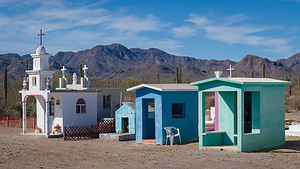 Roadside cemetery on the road to MulegeOn our drive down 1 to Mulege from Santa Rosalia, we passed a series of colorful buildings on the right, many of them with crosses and angels on their roofs. Wanting to see what they were, we made a U-turn and pulled into an unmarked dirt driveway. It turned out to be a cemetery and each of those small, colorful buildings was mausoleum. Set against a backdrop of cacti and mountains, it was a lovely, peaceful setting for families to visit their past loved ones. Each of the mausoleums contained photos, flowers, and various memorabilia associated with the deceased. These were obviously the graves of wealthy people, as their dwellings were far nicer than those for many of the living in northern Baja.
Roadside cemetery on the road to MulegeOn our drive down 1 to Mulege from Santa Rosalia, we passed a series of colorful buildings on the right, many of them with crosses and angels on their roofs. Wanting to see what they were, we made a U-turn and pulled into an unmarked dirt driveway. It turned out to be a cemetery and each of those small, colorful buildings was mausoleum. Set against a backdrop of cacti and mountains, it was a lovely, peaceful setting for families to visit their past loved ones. Each of the mausoleums contained photos, flowers, and various memorabilia associated with the deceased. These were obviously the graves of wealthy people, as their dwellings were far nicer than those for many of the living in northern Baja.
Rather than go directly to our hotel, which was located on the far side of the Rio Santa Rosalia de Mulege (Mulege River), which ran through town, we decided to stop first at the two historical sites mentioned in the Moon Baja guidebook.
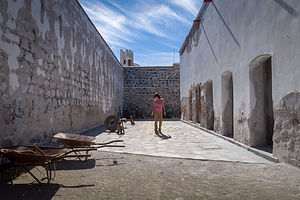 Museo Historico de MulegeOur first stop was the Museo Historico de Mulege, a one-time prison turned into a museum. In its day, the prison had quite a unique detention policy in that prisoners were allowed to leave during the day to work in town, but had to return to their cells by 6 pm each evening. Just in case they didn’t have watches, a conch shell was blown to inform them it was time to come back. There wasn’t much concern about anyone escaping, because before the Transpeninsular Highway (Mexico 1) was built in the 1970s, you couldn’t get too far from Mulege. Sort of the same theory for the placement of Japanese internment camps in the U.S.
Museo Historico de MulegeOur first stop was the Museo Historico de Mulege, a one-time prison turned into a museum. In its day, the prison had quite a unique detention policy in that prisoners were allowed to leave during the day to work in town, but had to return to their cells by 6 pm each evening. Just in case they didn’t have watches, a conch shell was blown to inform them it was time to come back. There wasn’t much concern about anyone escaping, because before the Transpeninsular Highway (Mexico 1) was built in the 1970s, you couldn’t get too far from Mulege. Sort of the same theory for the placement of Japanese internment camps in the U.S.
Today the museum houses an eclectic collection of historical artifacts - farm implements, typewriters, an old bomb, a colorful fake T-Rex, and much more.
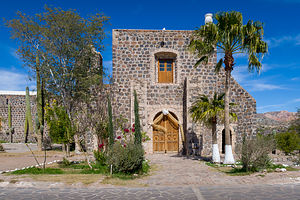 Mision Santa Rosalia de MulegeAfter the museum we drove over to the Mision Santa Rosalia de Mulege. It seemed that every decent-sized town had one. I assume the missions came first, and then the towns built up around them. Still, Baja had several missions that could only be reach via bumpy dirt roads.
Mision Santa Rosalia de MulegeAfter the museum we drove over to the Mision Santa Rosalia de Mulege. It seemed that every decent-sized town had one. I assume the missions came first, and then the towns built up around them. Still, Baja had several missions that could only be reach via bumpy dirt roads.
This particular mission was founded by a Jesuit priest named Padre Manuel de Basaldua, as a settlement for the local Cochimi natives, who he hoped to convert to Catholicism. When it was built in 1766, the Mision Santa Rosalia de Mulege became the fourth mission in Baja. This was the first mission that we were not able to enter because the doors were locked - and it was a Sunday. We assumed that perhaps there was an upcoming wedding, as there were wedding decorations on the door.
 Rio Santa Rosalia de MulegeBehind the mission, we climbed up the steps of a rocky viewpoint and looked down at the lush and palm-lined Rio Santa Rosalia de Mulege flowing beneath us. It had a very different feel from the desert terrain we had been driving through for days.
Rio Santa Rosalia de MulegeBehind the mission, we climbed up the steps of a rocky viewpoint and looked down at the lush and palm-lined Rio Santa Rosalia de Mulege flowing beneath us. It had a very different feel from the desert terrain we had been driving through for days.
Now that we had knocked off Mulege’s two major sites, we headed over to the Casa Granada, our home for the night. Their website photos didn’t lie. It really was lovely.
There was still a lot of time left to the day, so we took a drive down Mexico 1 to check out Playa Santispac, a very popular beach for camping on the Bahia Concepcion, especially so because it has a restaurant. It certainly was popular. There were large motorhomes lined up 10 feet apart all the way along the shoreline - not exactly our cup of tea. Also, the wind was so strong that camping in a tent would have been very unpleasant.
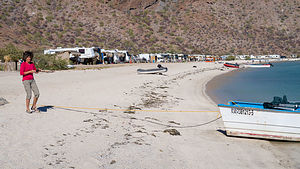 Windy Playa SantispacWe spoke for awhile with a girl from Colorado, who was sitting on the lee side of her truck with her dogs to get some protection from the wind. She said she had been coming to Baja since she was a kid and absolutely loved it. She had to go back to the States in a few days, but said she wanted to stay here 6 months next year. I have to say that I don’t get it. I guess we are not the types that are able to just chill for that long a time. We need to be moving - seeing new things and especially being active. To each his own.
Windy Playa SantispacWe spoke for awhile with a girl from Colorado, who was sitting on the lee side of her truck with her dogs to get some protection from the wind. She said she had been coming to Baja since she was a kid and absolutely loved it. She had to go back to the States in a few days, but said she wanted to stay here 6 months next year. I have to say that I don’t get it. I guess we are not the types that are able to just chill for that long a time. We need to be moving - seeing new things and especially being active. To each his own.
Afterwards, we decided to check out the beach by our hotel. It was still very windy and the beach was not particularly pretty. However, there was a view of the lighthouse across the river, and we had fun watching a mother and her two kids digging around in the sand near the water’s edge. Before long, one of kids picked up something big enough to require two hands. They all gathered around as mom went to work on it and soon handed them something that they put in their mouths. Not being aficionados of raw shellfish of any sort, as Herb is highly allergic, I assume that was the prize.
 Mulege lighthouseThat evening for the first time we did not have a restaurant in our hotel. We looked on TripAdvisor and found the La Serenidad Hotel next door had a very highly-reviewed restaurant. They were especially known for their Saturday night pig roasts, but since it was Sunday we would have to order off the menu.
Mulege lighthouseThat evening for the first time we did not have a restaurant in our hotel. We looked on TripAdvisor and found the La Serenidad Hotel next door had a very highly-reviewed restaurant. They were especially known for their Saturday night pig roasts, but since it was Sunday we would have to order off the menu.
The place did not look too impressive from the outside. In fact, it was surrounded on all four sides by a wall, making it appear like a military compound. We finally found the opening and were surprised how nice things were behind those walls - lovely pool where you could swim up to a bar, cozy restaurant with a fireplace, etc.
We got a table by the fireplace and had a delicious dinner . I had the fish tacos and Herb, once again, the chile relleno - he really needs to venture out a bit. Perhaps raw fish on the beach?
Description
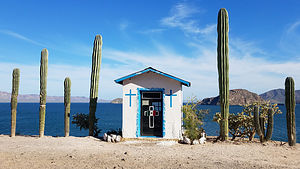 Roadside memorialMulege is a small colonial town located at the opening of the Bahia Concepcion on the Sea of Cortez. Unlike the desert topography of the north, Mulege is a lush green oasis with palm trees, with the Rio Santa Rosalia de Mulege (Mulege River) running through before meeting up with the Sea of Cortez. In fact, “Mulege” is the Cochimi word for “large sandbar of the white mouth”.
Roadside memorialMulege is a small colonial town located at the opening of the Bahia Concepcion on the Sea of Cortez. Unlike the desert topography of the north, Mulege is a lush green oasis with palm trees, with the Rio Santa Rosalia de Mulege (Mulege River) running through before meeting up with the Sea of Cortez. In fact, “Mulege” is the Cochimi word for “large sandbar of the white mouth”.
In 1705, a Jesuit priest named Padre Manuel de Basaldua traveled north from Loreto to found a settlement for the local Cochimi natives. When it was built in 1766, the Mision Santa Rosalia de Mulege became the fourth mission in Baja. To visit this lovely stone church, follow Calle Zaragoza west up a slight hill.
Another place of historical interest is the Museo Historico de Mulege, a one-time prison turned into a museum. In its day, the prison was quite unique in its policy of allowing prisoners to leave during the day to work in town. 6 pm each evening, they were called back to their cells by the blowing of a conch cell. There wasn’t much concern about anyone escaping, because before the Transpeninsular Highway (Mexico 1) was built in the 1970s, you couldn’t get too far. Today the museum houses an eclectic collection of historical artifacts.
Santa Rosalia
Sunday, February 24, 2019 - 6:45pm by Lolo22 miles and 0.5 hours from our last stop
Travelogue
 Iglesia de Santa Barbara de Santa Rosalia (Eiffel Church)Not wanting to linger for a mystery breakfast at Las Tres Virgenes, we had a quick Nature Valley bar and yogurt and hit the road, heading south on Mexico 1 towards Mulege, where we had a hotel reservation for the night. I was protesting the lack of coffee, but Herb didn’t want to use our camping stove for fear of setting our little rustic wooden cabin on fire.
Iglesia de Santa Barbara de Santa Rosalia (Eiffel Church)Not wanting to linger for a mystery breakfast at Las Tres Virgenes, we had a quick Nature Valley bar and yogurt and hit the road, heading south on Mexico 1 towards Mulege, where we had a hotel reservation for the night. I was protesting the lack of coffee, but Herb didn’t want to use our camping stove for fear of setting our little rustic wooden cabin on fire.
The scenery was quite lovely as we approached the town of Santa Rosalia, mountains giving way to our first glimpses of the Sea of Cortez. As we approached the town of Santa Rosalia, we were confronted with two very contrasting views - the lovely, sparkling waters of the sea, and the industrial remnants of an old mining company. It was up to us whether we saw the gnarly old lady or the pretty young woman (optical illusion referred to in my trip overview). Without coffee, I was focused on the old lady.
The mining equipment along the highway once belonged to the thriving French El Boleo Mining Company, who founded the town in the 1880s and developed its infrastructure in return for the rights to mine the copper in the area. As a result, the town has a distinct French feel to it, very different from any we had seen to date.
There even was a church in town, the Iglesia de Santa Barbara, that was designed by Gustave Eiffel (of Eiffel Tower fame). Seeing that, and getting a much-needed cup of coffee, was the reason we turned off into the town.
 Interior of Eiffel ChurchThe town was quite nice, with people bustling about in their Sunday finest on their way to festivities in the town plaza. The town was well-kept with upscale shops and lots of restaurants. It also happened to be the first town we visited in Baja Sur (as opposed to Baja Norte), which I don’t think was just a coincidence. From this point on, we would be along the Sea of Cortez, a big attraction for adventure tourists.
Interior of Eiffel ChurchThe town was quite nice, with people bustling about in their Sunday finest on their way to festivities in the town plaza. The town was well-kept with upscale shops and lots of restaurants. It also happened to be the first town we visited in Baja Sur (as opposed to Baja Norte), which I don’t think was just a coincidence. From this point on, we would be along the Sea of Cortez, a big attraction for adventure tourists.
Of course, we stopped to see Santa Rosalia’s biggest attraction, the church designed by Gustave Eiffel. The story behind the church is quite interesting:
Eiffel never actually came to Santa Rosalia. Rather, back in 1884 while still in France, he designed a prefabricated metal church, made entirely of stamped steel sheet squares for easy portability, as a prototype for missionary churches in France’s tropical colonies. After being displayed at the 1889 Paris World's Exposition, where it won first prize for church design, it was stored in a Brussels warehouse and almost forgotten.
Meanwhile, back in Baja, the Boleo Mining Company had almost completed developing Santa Rosalia as a place for their miners to live. The one thing they still needed was a church. An official of the mining company learned of the church stored away in the Brussels warehouse and had it shipped to Santa Rosalia where it was reassembled in 1897. Sort of like a modern-day Ikea project.
Now on to Mulege.
Description
 Santa Rosalia street artSanta Rosalia, in the northern part of Baja Sur, is the first town along Mexico 1 that is on the Sea of Cortez.
Santa Rosalia street artSanta Rosalia, in the northern part of Baja Sur, is the first town along Mexico 1 that is on the Sea of Cortez.
The town was founded in the 1880s by the French El Boleo Mining Company after copper was discovered in the area. The French were granted a 99 year concession in exchange for developing the town infrastructure. Hence, the distinct French feel to the town.
By 1900, Santa Rosalía had become a major world copper producer. However, the copper deposits were eventually exhausted and the El Boleo mining company closed in 1954. However, a Mexican state-owned company took it over until it was finally shut down in 1985. The area is still full of relics from the old mining days.
Another reminder of Santa Rosalia’s French past is the Iglesia de Santa Barbara (Church of Santa Barbara), which was designed by Gustave Eiffel (of Eiffel Tower fame). Eiffel never actually came to Santa Rosalia. Back in 1884 while still in France, he designed a prefabricated metal church, made entirely of stamped steel sheet squares for easy portability, as a prototype for missionary churches in France’s tropical colonies. After being displayed at the 1889 Paris World's Exposition, where it won first prize for church design, it was stored in a Brussels warehouse and almost forgotten.
Meanwhile, in Baja, the Boleo Mining Company had almost completed developing Santa Rosalia as a place for their miners to live. The one thing they still needed was a church. An official of the mining company learned of the church stored away in the Brussels warehouse and had it shipped to Santa Rosalia where it was reassembled in 1897.
The town is now experiencing a bit of an economic recovery due to a boom in adventure tourism and its proximity to the Bahia Concepcion. The completion of a ferry service across the gulf to mainland Mexico has also helped Santa Rosalia become a thriving tourist and service center for central Baja.
Eco Tour Las Tres Vírgenes
Saturday, February 23, 2019 - 10:45am by Lolo70 miles and 2.5 hours from our last stop - 1 night stay
Travelogue
 Eco tour cabins at Las Tres VírgenesSince our entire drive through Baja was along one two-lane highway (Mexico 1), we pretty much knew from the guidebooks everything there was to see.
Eco tour cabins at Las Tres VírgenesSince our entire drive through Baja was along one two-lane highway (Mexico 1), we pretty much knew from the guidebooks everything there was to see.
After San Ignacio, the next notable site was Volcan Las Tres Virgenes, a series of three dormant stratovolcanoes - El Viejo, El Azufre, and La Virgin. They are part of the Desert Biosphere Reserve of El Vizcaino, an important habitat for endangered species, such as the bighorn sheep, about 500 of which live near the volcano.
According to the guidebooks, the only lodging option in the area is Eco Tour Las Tres Virgenes, which has 5 very rustic cabins (10 rooms) and a restaurant. Before leaving home, I had tried emailing them to see if any of the cabins would be available during the range of time we would be passing through, but despite repeated attempts, I had not heard back, so I wasn’t even sure if they were still in operation.
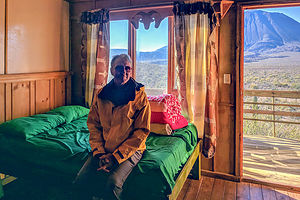 Herb enjoying his rustic cabin at Las Tres VírgenesThe views of the volcanoes was supposed to be stunning, so we figured we would take the short drive off of Mexico 1 and see if we could spend the night.
Herb enjoying his rustic cabin at Las Tres VírgenesThe views of the volcanoes was supposed to be stunning, so we figured we would take the short drive off of Mexico 1 and see if we could spend the night.
Our Moon Baja guide is very detailed in providing directions, so as directed at kilometer 31 (where there was a Federal Police car hanging out) we turned left onto a paved road and followed it for 3 km, before turning left onto a dirt road lined with white rocks leading to the lodge.
It seemed pretty deserted and at first we thought no one was there. As we were wandering around a woman came out and approached us. She spoke absolutely no English, but we knew enough Spanish to successfully determine that she did have a cabin available for us and that we should give her 20 minutes to clean it. The cost was 350 pesos ($18).
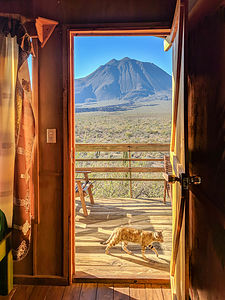 Our gato at Eco Tour Las Tres VírgenesI also quite incompetently tried to find out about dinner options. Stupidly, I asked for a menu, as if I was back in a New Jersey diner. There was no menu. Our entree would be whatever they were cooking that night. I wanted to make sure that whatever they served would not include shellfish, as Herb is highly allergic. I managed to say the Spanish word for shellfish, which is mariscos, while Herb put his hands around his neck and pretended to be choking himself. The woman just stared at him, probably thinking he was loco, and then said, “sopa de pollo,” to which we responded “Si”.
Our gato at Eco Tour Las Tres VírgenesI also quite incompetently tried to find out about dinner options. Stupidly, I asked for a menu, as if I was back in a New Jersey diner. There was no menu. Our entree would be whatever they were cooking that night. I wanted to make sure that whatever they served would not include shellfish, as Herb is highly allergic. I managed to say the Spanish word for shellfish, which is mariscos, while Herb put his hands around his neck and pretended to be choking himself. The woman just stared at him, probably thinking he was loco, and then said, “sopa de pollo,” to which we responded “Si”.
While we were waiting, we tried to make nice with the two perros (dogs) that seemed to own the place. Also while waiting, the Federal Police car drove in, which I have to admit made me a little nervous. Herb joked that they were stopping by to get their donuts. He wasn’t too far off because we later saw them having lunch in the restaurant.
There was also a man dressed in camo gear sitting at a table in the dining room by himself. Right behind him were a series of photos, one of which showed a hunter with a gun and his kill, which happened to be a bighorn sheep. I glanced back and forth from the man at the table to the photo and back to the man again. It was him. He must be one of the hunting guides that take wealthy Americans the Reserve to shoot bighorn sheep. I don’t understand how they allow endangered bighorn sheep to be killed in a Reserve that is supposed to protect them, but I guess at the $10,000 a head that American big game hunters are willing to pay for one of these prize animals, an exception is made. Thankfully, at least the number of sheep allowed to be killed is limited to 6 or so a year.
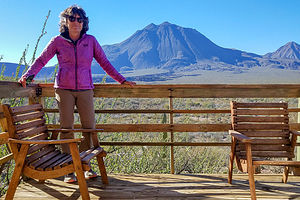 Our balcony overlooking the volcanoesAs promised, the woman returned and asked us to follow her to our cabin. She did not give us a key, as there was no lock on the door. The cabin was very rustic with a non-functional sink and a draft through the gaps in the wood. However, it was still better than sleeping in the 4Runner and the views of the valley and the volcanoes from our balcony were absolutely stunning.
Our balcony overlooking the volcanoesAs promised, the woman returned and asked us to follow her to our cabin. She did not give us a key, as there was no lock on the door. The cabin was very rustic with a non-functional sink and a draft through the gaps in the wood. However, it was still better than sleeping in the 4Runner and the views of the valley and the volcanoes from our balcony were absolutely stunning.
We spent the final hours of sunlight, sitting on our balcony while watching the sunset over the volcanoes. It was quite lovely.
Not sure about the restaurant’s wine list, we poured ourselves a glass of wine and walked over to the restaurant, assuming it was a BYOB. Cooking dinner in the kitchen were three generations of women - grandma, the woman we had dealt with before, and her daughter.
 Morning light on Las Tres VirgenesThe soup as good, but different than I expected in that the chunks of chicken in it were beyond bite-sized yet there was no easy way to break them up. Not wanting to use our choking sign for real, we managed to hack them with our spoons into a swallowable size. It was actually quite good.
Morning light on Las Tres VirgenesThe soup as good, but different than I expected in that the chunks of chicken in it were beyond bite-sized yet there was no easy way to break them up. Not wanting to use our choking sign for real, we managed to hack them with our spoons into a swallowable size. It was actually quite good.
There was no check, so I asked grandma, “Cuanto questa?” to which she placed her fingers close together and said “un poco”. However, her daughter cut in with more specifics and said 300 pesos ($15.50), which was almost as much as our cabin cost.
Back at the cabin, I half kiddingly asked Herb to place a chair in front of the unlocked door, so no one could get in. He suggested to me that that was unnecessary, but that chair eventually wound up against the door when the wind started blowing it open during the night.
The next morning we took photos of the volcanoes in the morning light before hitting the road again. Next stop, Mulege.
Description
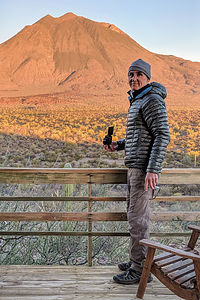 Herb welcoming Las Tres Virgenes to a new dayAbout 45 minutes east of San Ignacio along Mexico 1 are the Las Tres Virgenes, a series of three dormant stratovolcanoes - El Viejo, El Azufre, and La Virgin. They are part of the Desert Biosphere Reserve of El Vizcaino, an important habitat for endangered species, such as the bighorn sheep, about 500 of which live near the volcano.
Herb welcoming Las Tres Virgenes to a new dayAbout 45 minutes east of San Ignacio along Mexico 1 are the Las Tres Virgenes, a series of three dormant stratovolcanoes - El Viejo, El Azufre, and La Virgin. They are part of the Desert Biosphere Reserve of El Vizcaino, an important habitat for endangered species, such as the bighorn sheep, about 500 of which live near the volcano.
Hiking to the summit of the volcano requires is a 2-day trek, requiring the accompaniment of a local guide. Those that reach the summit are rewarded with views of the Sea of Cortez to one side and the Pacific Ocean to the other.
Despite the endangered status of the bighorn sheep, limited hunting is allowed at certain times of the year. In 2006, six bighorn sheep were allowed to be killed, and American big game hunters paid $60,000 (U.S. dollars) for that privilege.
The only option for lodging in the area is Eco Tour Las Tres Virgenes, managed by a local ejido (a family that holds the land communally). There are 5 very rustic cabins (10 rooms) with stunning views of the expansive valley and volcanoes. There is also a restaurant on site.
To get there, turn off Mexico 1 at kilometer 31 onto a paved road. After 3 km, turn left onto a dirt road lined with white rocks to the lodge.
